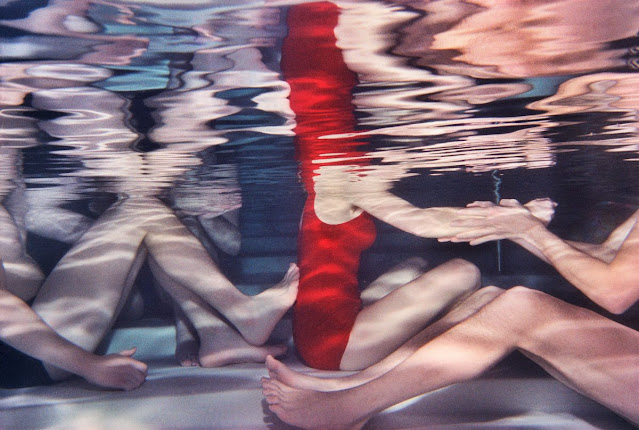
|
Swimmers. By Larry Sultan
|
Photographs by Larry Sultan
MACK, London, UK, 2023. 144 pp., 11¼x10¾".
In the late summer of 2020, before vaccines, before wildfires in California, but very much after the onslaught of the pandemic, I started going to a local pool. My fellow swimmers and I were checked-in, our temperatures taken and recent travel history surveyed. Then we walked out onto the pool deck, the sun still climbing behind a tall stand of eucalyptus trees. Another world was now within reach. We traded N95 masks for goggles and dove in.
It was the closest I’d come to being in a crowd for six months and I was surprised by the tenderness I felt for strangers, these creatures who’d suffered and survived, who were indeed still in the midst of surviving, as we all still are every day. You could mistake the subtle taste of the saltwater pool for tears.
We shared the small outdoor pool with an aqua aerobics class. The instructor curated new playlists for her students each day. Sometimes it was a Latin dance beat, other times it was Patsy Cline. On Halloween, I heard “The Monster Mash” before diving in. Underwater, the music evaporated. I watched the bodies try to move in unison. They were tentative, floating lightly on tip-toe, like babies in first-steps videotapes. They strained lightly and leapt slowly. It was comedic, but also poignant, the way the diffuse light made everything gently beautiful. Sharing public space together was an act of trust. Our bodies were fragile and solid and strong all at once.
 |
The same sense of wonder colors Larry Sultan’s Swimmers, collected in a new book by Mack. Sultan worked on the series for around a decade, beginning in the early 1970s. He visited public swimming pools in the San Francisco Bay Area, photographing underwater with a Nikonos III. Philip Gefter’s enlightening introduction to the book places the series at a transitional point in Sultan’s career. He had published Evidence, with Mike Mandel, in 1977. Gefter notes that Sultan received some criticism from viewers at the time who accused him of formalism upon seeing Swimmers. They were disappointed by this subjective, nearly narrative turn from the conceptual artist. But, Gefter argues, it was crucial to the development of Pictures of Home, which is now arguably Sultan’s best-known work.
 |
 |
The Swimmers pictures are captivating. In the new book, they are printed in muted color on black pages. The sequence shows the recurring themes to great effect. Moving from solo swimmers to groups and back, the book is animated by that same sense of fascination I found underwater at the pool. The awkwardness of being in water strips away the years. We are children underwater; it seems to reveal our most basic facts, from the shapes of our bodies to our social rituals, made visible here by the way people cling to each other or struggle to hold themselves in place against the lightly rocking tide.
I realize in looking at Sultan’s pictures that it’s impossible to pose underwater. Literally out of our element, we can’t hold ourselves in the ways we want to. We can barely hold still. Even in the few pictures that feature eye contact, the swimmer is hardly smiling for the camera. All their effort is on breathing underwater, their lips pursed and eyes glassy.
 |
The focus on the body is exaggerated by the fact that Sultan’s camera rarely breaks the surface. These swimmers are mostly anonymous Aphrodites without heads. But their humanity and the humanity of Sultan’s pictures is unmistakable. Submerged in this most vital element, Sultan revealed something vital and fragile about human beings. The people in these pictures appear timeless, despite the fact that Sultan’s Apollos wear Speedos instead of togas.
Purchase Book
Read More Book Reviews
 |
 |









